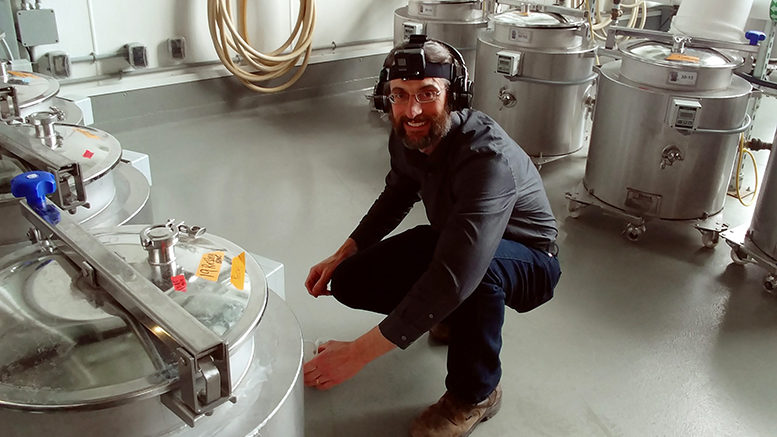With a video camera strapped to his head, Paul Brock stood alone in a lab in the Viticulture and Wine Center at Finger Lakes Community College (FLCC) on a recent weekday afternoon.
He instructed his students just as he would have if they had shared the same space. The GoPro camera recorded the lesson, which was streamed in real-time on the internet.
Brock’s students may not have been in the lab in Geneva, New York, but they were present nonetheless, watching from the comfort – and safety – of their homes.
As the coronavirus pandemic made its way across the nation in early March, college students left campuses, their in-person courses transferred online. For degree programs centered on hands-on learning, like FLCC’s viticulture and wine technology, the challenge to teach entirely online at first seemed insurmountable.
However, faculty members like Brock have teamed up with colleagues to find creative ways to connect with students and continue with courses dependent on laboratory and experiential learning.
“When we were told that there will be no in-person classes, I had to figure out a way to make our hands-on learning curriculum accessible through a screen,” said Brock, associate professor of viticulture and wine technology. “I know that watching videos is not a way to learn how to do things with your hands. I also know that many students struggle with the traditional online learning model of do-the-work-when-you-can.”
Overcoming technical challenges
While some instructors have opted to give students the opportunity to complete online studies on their own time, Brock decided to continue to meet with students during the regularly scheduled class times. His students log onto a virtual classroom using the Webex application. The Webex meetings were only part of the solution, however. Brock also considered offering prerecorded videos of his lessons, but that wouldn’t let him engage with his students.
“I needed students to see what I was doing with my hands in real-time so that they could ask questions and get my response,” Brock said. “This was really about me needing to teach in the vineyard. Students are learning techniques and skills that they normally would be practicing hundreds if not thousands of times in the field during our lab times. So, I decided offering them the real-time video feed of my hands doing these skills repetitively would be the best way to substitute them doing it.”
Brock enlisted the help of FLCC’s information technology division. Media production specialist Bill Pealer was on the case. With advice from Jonathan Weissman, associate professor of computing sciences, Pearler devised a plan using a GoPro as a live field camera. Wifi is needed for the video camera to stream live; a mobile hotspot with unlimited data was set up to ensure connectivity in the lab as well as remote vineyard locations.
“That was a huge challenge. There is no power out there,” Pearlier said.
Another problem: Livestreaming quickly drains the GoPro battery. Using his own 3D printer, Pearler created a device that allowed the GoPro to connect to a small battery extender.
“This extends the live stream from one hour to the full three hours of Paul’s class,” Pealer explained. “This is all battery-run. No laptops, no desktops, no wall outlets and only one cable. Everything is as small as a cell phone – or smaller.”
Field testing
After several days of troubleshooting and collaboration with colleague Rob Finger, Pearler found a social media platform on which Brock could share the livestream with students while sharing an audio connection in Webex.
“I had my concerns, as I’m sure many of the viticulture students had, when we first found out we would be transitioning to an online form of learning,” said student Michael Hiller. “It’s obvious that Paul put time and thought into this and truly cares about the quality of education his students receive, even with an obstacle like this pandemic we now find ourselves in.”
One of the first lessons – archived on Brock’s viticulture education Facebook page – began with some simple rules. It was a bit of a test run.
“Be sure to mute your feed,” Brock told his students before pulling plastic beakers from a cupboard. The GoPro showed his hands fast at work, writing labels on tape and affixing to the beakers.
“How are you guys doing so far?” he asked them.
The students offered assurances as Brock listened through a headset.
A few moments later, the GoPro showed Brock in another part of the viticulture center, pouring samples of wine into the labeled cups.
“Whenever you take a sample, you dump the first little bit,” he explained.
Another archived lesson shows Brock working under overcast skies in a vineyard. Step-by-step, he guides students through the process of repairing trellises for the grapevines.
“It is a miracle of modern technology and determination that we are able to do this,” Brock said. “I am live streaming from a rural vineyard to the world, with both hands free, alone, communicating with my students with only about four or five pounds of tech strapped to me! It all cost less than $1,000 of off the shelf parts.”
Still, Brock is looking forward to a time when he can be back teaching face-to-face.
During a recent lab, while he places droplets of wine on photosensitive paper, Brock tells students: “I hope you guys can get a good feel for what I’m doing. Hopefully in the fall, we will all be able to do this together.”

